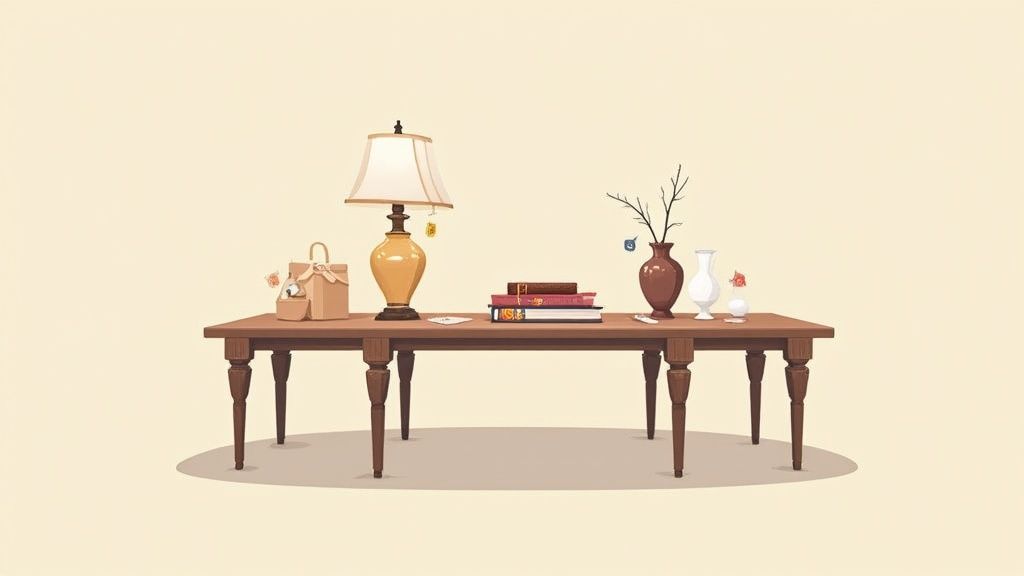A good estate sale pricing guide isn’t about just slapping a sticker on grandma’s old lamp and hoping for the best. It's a delicate dance between solid research, a little bit of sales psychology, and a clear, well-executed plan. Getting it right means finding that sweet spot—the fair market value—that helps you clear the house efficiently while still bringing in the most money possible.
Think of it like you're running a high-stakes, one-weekend-only retail store. Your strategy is everything.
The Art of Smart Estate Sale Pricing
Let’s be real for a minute: pricing an entire household of possessions is a massive undertaking. It can feel completely overwhelming. You're not just selling things; you're often handling someone's legacy, trying to turn a profit, and needing to empty a home, all at the same time.
But here’s the secret: professionals don't get bogged down by that pressure. They reframe the challenge. The key is to think like an experienced seller and understand that every single item has a specific value in this specific context. Your job is to consistently hit the "fair market value"—that’s simply the price a ready buyer is willing to pay a ready seller, right here, right now. It's not about sentimental value or what something cost 20 years ago. It’s about a smart, repeatable game plan.
Core Factors That Drive Estate Sale Prices
Before you even think about looking up a single item, you need to get a feel for the handful of factors that truly dictate value. These are the core variables that will influence every price tag you write. Understanding them from the start helps you make quicker, more confident decisions when you're standing in a room full of stuff.
Here’s a quick overview of what really matters when you're setting prices.
Core Factors That Drive Estate Sale Prices
| Pricing Factor | Description | Impact on Price |
|---|---|---|
| Condition | The physical state of the item—any chips, cracks, stains, or damage. | High: Flawless, like-new items command top dollar. Even minor damage can significantly lower value. |
| Desirability | Current market demand, which is heavily influenced by trends, styles, and what's collectible right now. | High: Hot items like mid-century modern furniture or rare vinyl records sell for much more. Outdated styles sell for less. |
| Rarity | How difficult the item is to find. Is it a one-of-a-kind piece or was it mass-produced by the thousands? | High: Anything scarce or hard to come by will naturally have a higher value simply because there isn't much of it around. |
| Staging | How and where an item is displayed in the home. Presentation matters more than you think. | High: A crystal vase shimmering under a light on a dining room table looks far more valuable than the same vase in a dusty box in the garage. |
Keeping these elements in mind from the get-go is how you avoid rookie mistakes. You'll quickly learn why a slightly chipped but incredibly rare piece of pottery might be worth far more than a pristine, but common, modern vase.
The single biggest mistake people make is pricing items based on what they originally paid for them or on sentimental attachment. An effective estate sale pricing guide always puts current market demand and what an item can realistically sell for today first.
This shift in mindset is crucial. Instead of asking, "What was this worth?", you need to be asking, "What will someone pay for this, at this sale, this weekend?" The answer is found through a mix of solid research, strategic timing, and knowing your audience.
For a more detailed walkthrough of these foundational steps, our complete guide on how to price estate sale items is the perfect next step. Ultimately, a successful sale isn't about luck; it's about good planning. It turns a daunting task into a genuinely profitable and satisfying project.
How to Confidently Research Item Values
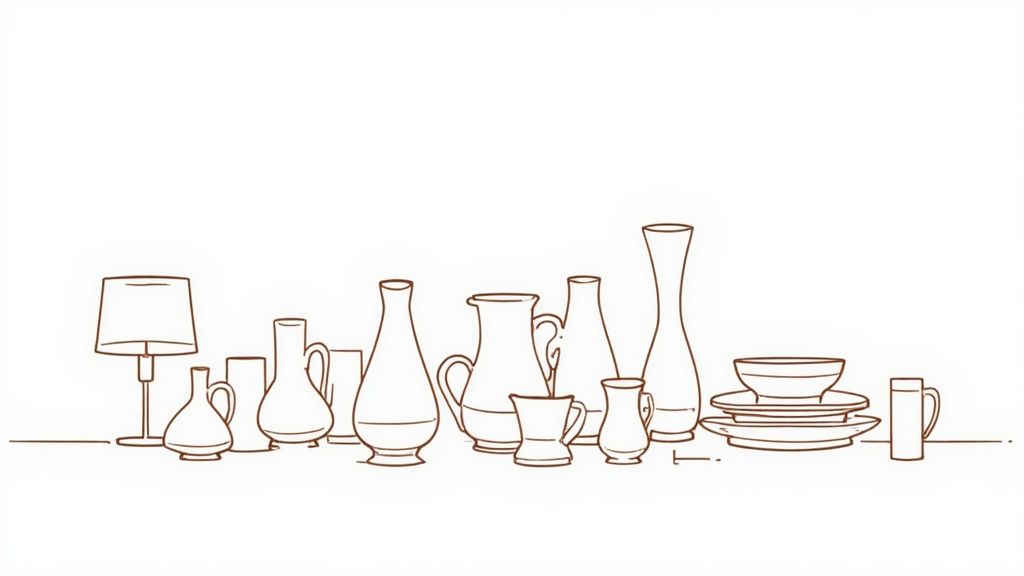
So, how do you figure out what something is really worth? This is where a solid estate sale pricing guide turns from a guessing game into a reliable process. You need a practical way to decode an item's value without getting sucked into an endless black hole of online searches.
The goal isn't just to find a price. It's to find the right price for the right buyer at your specific sale.
Think of yourself as a detective. The item in your hands is the first clue, but the real answers come from digging into the evidence. And the most important piece of evidence isn't what people are asking for online—it's what buyers have actually paid.
Go Straight to the "Sold" Listings
This is the biggest mistake I see people make. They hop on eBay, search for an item, and use the current listings as their pricing benchmark. That’s a trap. An asking price is just a wish; a sold price is a fact.
To do this right, you have to filter your searches to show only completed sales. On eBay, for instance, you can use the advanced search options and check the "Sold listings" box. Taking this one simple step immediately shifts your research from wishful thinking to data-driven pricing.
Why is this so critical?
- It reflects real demand. You see exactly what the market is willing to pay for that item, in that condition, right now.
- It cuts through the noise. You can completely ignore all the ridiculously overpriced items that have been sitting there for months.
- It gives you a realistic range. You’ll see the highs and the lows, which helps you establish a practical price range to work within.
Don't just look at one or two. Try to find a dozen or so sold listings for a similar item to get a truly accurate picture of its fair market value.
Using Specialized Research Tools
While eBay is fantastic for everyday items, it's not the final say—especially when you're dealing with antiques, collectibles, or other specialized goods. For these treasures, you'll need to dig a bit deeper. Think of it like a family doctor consulting a specialist for a complex diagnosis.
The difference between an amateur and a pro is knowing which tools to use. For common items, a quick market check is fine. For unique treasures, you need to consult the experts and specialized databases to unlock their true value.
Here are a few resources to consider for more nuanced research:
- WorthPoint: This is a beast. It's a massive database that pulls sales data from hundreds of auction houses and online marketplaces.
- Replacements, Ltd.: The absolute go-to for pricing individual pieces of china, silver, and crystal patterns.
- LiveAuctioneers & Invaluable: These sites are goldmines for past auction results from all over the world. They're perfect for art, fine furniture, and high-end collectibles.
These tools often have a subscription fee, but many offer a free trial that can be incredibly useful while you’re prepping for a sale. They provide a depth of information that a simple Google search will never be able to match.
When to Call a Professional Appraiser
Every now and then, you’ll come across an item that just feels special. It could be fine jewelry, a signed piece of art, a rare historical document, or a piece of high-end antique furniture. In these moments, trying to research it yourself can be a huge risk. Get it wrong, and you could be leaving thousands of dollars on the table.
It's time to hire a professional appraiser when:
- The item is potentially high-value (my rule of thumb is anything you suspect is worth over $1,000).
- You can't find any comparable sales through your own deep-dive research.
- Authentication is needed, like for fine art, artist signatures, or designer goods.
To find someone you can trust, look for professionals certified by organizations like the Appraisers Association of America (AAA) or the International Society of Appraisers (ISA). They follow strict ethical codes and have the specialized knowledge to give you an accurate, defensible valuation. This investment not only ensures you price things right but gives you the rock-solid confidence to stand by that price.
Mastering Your 3-Day Markdown Strategy
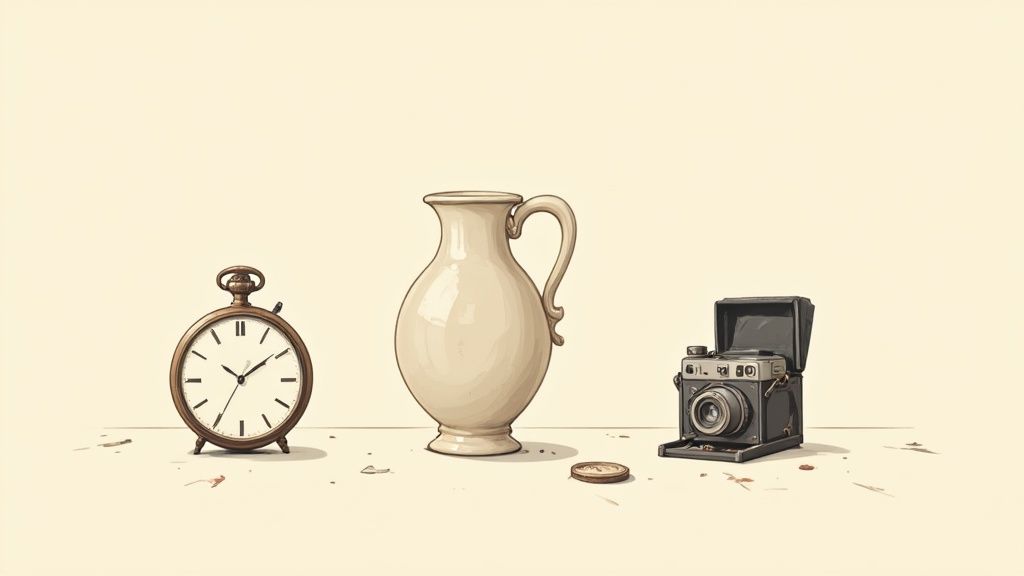
A great sale isn't just about the initial price tags; it's about the rhythm of the sale itself. The secret weapon of seasoned professionals is a dynamic markdown strategy. Think of your three-day sale as a performance in three acts. Each day has its own mission, its own audience, and a pricing plan designed to build momentum and urgency.
This timed discount model is the industry standard for a very good reason—it’s the best way to balance making the most money with the non-negotiable goal of clearing out the house.
Day One: The Full-Price Opening
The first day is all about capturing peak value. When those doors open, you’ll get a rush of the most motivated buyers. These are the serious collectors, the sharp-eyed resellers, and the dedicated folks who've been studying your preview photos and know exactly what they want.
These early birds expect to pay for the privilege of getting first pick. That’s why Day One prices are firm. This is not the time to start haggling. You’ve done your homework and priced things at fair market value, so stick to your guns with confidence.
Your mission on day one is clear: sell your premium items to the most eager shoppers for the best possible price. Resisting the temptation to discount right out of the gate sets a professional tone for the entire event.
Day Two: Building Momentum with Smart Discounts
By the time the second day rolls around, the initial frenzy has usually calmed down. Your focus now pivots from holding firm to keeping the sales floor buzzing and the inventory moving. This is where your first strategic discount makes its entrance.
A typical Day Two markdown is 25% off most items. This is the sweet spot—a significant enough price drop to entice a fresh wave of shoppers who might have hesitated on day one. It also gives those first-day visitors a great reason to come back for a second look at things they were on the fence about.
This 25% reduction strikes a crucial balance. It injects new energy into the sale without taking a huge bite out of your total profits. It keeps things from stagnating, which is the last thing you want.
A well-timed discount schedule is your secret weapon. It creates a psychological pull, turning hesitant browsers into decisive buyers by introducing the fear of missing out on a great deal.
According to veteran estate sale professionals, the first day is for capturing the highest prices from keen buyers. The following days then introduce systematic discounts to draw in bargain hunters and ensure the house is cleared. A common schedule is 25% off on the second day and a 50% reduction on the third, with deals getting even better in the final hours. However, certain high-value categories, like fine jewelry, artwork, or precious metals, often have tighter discount caps, rarely going beyond 25% to protect their value.
Day Three: The Final Push to Liquidate
Welcome to the final act. On Day Three, the main objective changes. It’s no longer about maximizing profit on every single item; it's about liquidating what’s left. This is the day for the true bargain hunters.
The standard approach is 50% off everything, and you might even go deeper in the last few hours of the sale. This is also a great time to get creative with deals like a "fill-a-bag for $10" offer to clear out kitchen gadgets, linens, or other small miscellaneous items. This aggressive pricing creates a final, powerful surge of traffic, ensuring you’re left with as little as possible. Having a solid organizational plan is also essential for a smooth final day, which you can learn about in our guide on how to organize an estate sale.
Of course, there are always a few exceptions to the 50% off rule.
- High-Value Items: That piece of fine art or rare antique probably shouldn't be slashed in half. You can mark these items as "firm" or set a maximum discount of 25%. You don’t want to give away a treasure.
- Bid Sheets: For truly unique or in-demand pieces, a bid sheet can be a great tool. Let shoppers write down their best offer throughout the sale, and simply sell to the highest bidder at the end.
By following this proven 3-day structure, you’ll create a perfectly paced event that attracts every kind of shopper. It’s the best way to earn the most money while achieving that ultimate, satisfying goal: an empty house.
Pricing Common Household Items Like a Pro
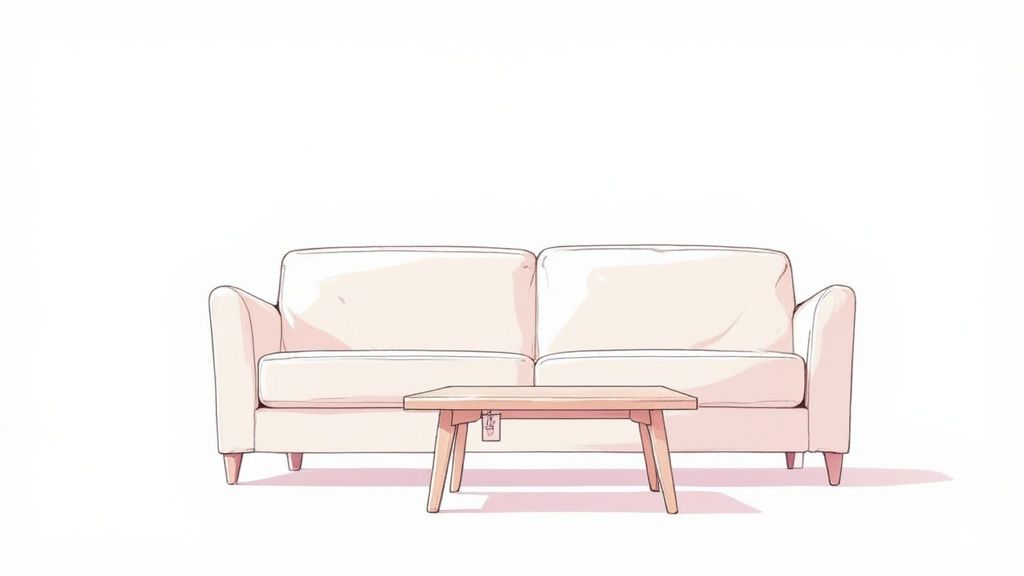
General research and markdown schedules are great, but the real work begins when you’re standing in a room, staring at a lamp or a dresser, and thinking, "Okay, what is this actually worth?" This is where experience, or a really good guide, comes into play. Let's break down the most common categories you'll encounter and how to put a smart price tag on them.
Think of it this way: every category has its own unwritten rules. Pricing a solid oak dresser is a completely different ballgame than pricing a stack of everyday Corelle plates. Understanding the signals of value for each type of item is how you avoid the classic mistakes—selling a hidden gem for pennies or putting a ridiculously high price on a common piece that will just sit there all weekend.
My goal here is to give you solid starting points and teach you the right questions to ask for everything in the house.
Furniture: From Dressers to Dining Sets
Furniture pieces are often the big-ticket items that anchor an estate sale. They're what draw in many serious buyers looking for quality without the retail markup. The value really boils down to three things: brand, material, and condition. A piece from a well-known maker like Ethan Allen or Henredon will always fetch more than generic, mass-produced furniture.
For solid wood furniture in good shape, a good rule of thumb is to start at 30-50% of what a similar new piece would cost. On the other hand, for items from brands like IKEA or anything made of particle board, you have to price aggressively. We're often talking in the $10-$50 range, depending on how useful and sturdy it still is.
Here's what to look for:
- Material: Is it solid wood, a wood veneer, or particle board? Solid wood is king.
- Construction: Check the drawers. Dovetail joints are a classic sign of quality craftsmanship.
- Condition: Scratches, water rings, and wobbly legs are price killers. Be realistic about flaws.
Clothing and Accessories
The closet can be a mixed bag, ranging from everyday apparel to a few truly special designer items. For standard, used clothing from mall brands (think Gap, Old Navy, etc.), you need to price it to move. Aim for $3-$8 per item, or even better, bundle things together. Five t-shirts for $10 is an easy sell.
However, vintage clothing (generally 20+ years old) and designer labels are a whole different beast. That 1970s leather jacket or a classic Coach bag requires some homework. Look up what similar items have actually sold for online—the current market value can be surprisingly high.
Don't just lump all old clothing into a "used" pile. A true vintage or designer piece can be one of the most valuable items per square inch in the home. Treat these finds like the treasures they could be and research them carefully.
Books and Media
Let's be honest: most modern paperbacks aren't worth much. The best strategy here is to sell them in bulk. Price them at $1 per book or offer a full bag for $5. People love stocking up on cheap beach reads.
But you have to keep your eyes peeled for the exceptions. Look for:
- First Editions: Check the copyright page. A first edition from a famous author can be worth hundreds, sometimes even thousands.
- Signed Copies: An author's signature instantly adds value.
- Niche Collections: A large group of books on a specific topic, like military history or a single author's entire works, can be sold as a lot for a good price.
Vinyl records have also made a huge comeback. Common LPs from the 70s and 80s might only go for $1-$5, but rare pressings or classic rock and jazz albums in great condition can easily sell for $20 or much more.
Kitchenware and Decor
The kitchen is usually packed to the gills. For everyday dishes, glassware, and utensils, you have to price low. A good guideline is to price these items at about 10-30% of their original retail price. Bundling is your best friend here. A box of assorted drinking glasses for $8 or a set of pots and pans for $25 will disappear quickly.
Fine china and crystal are priced differently. Brands like Lenox, Wedgwood, or Waterford demand individual research. I always use a resource like Replacements, Ltd. to identify the pattern and see its market value, then price my pieces at roughly 25-40% of their listed value to ensure they sell.
When it comes to home decor, value is incredibly subjective and follows trends. The best approach is to price these items to be impulse buys. Think $5-$25 for most decorative pieces, unless you can identify something as a high-end brand, a known collectible, or a genuine antique.
How Market Trends Affect Your Prices
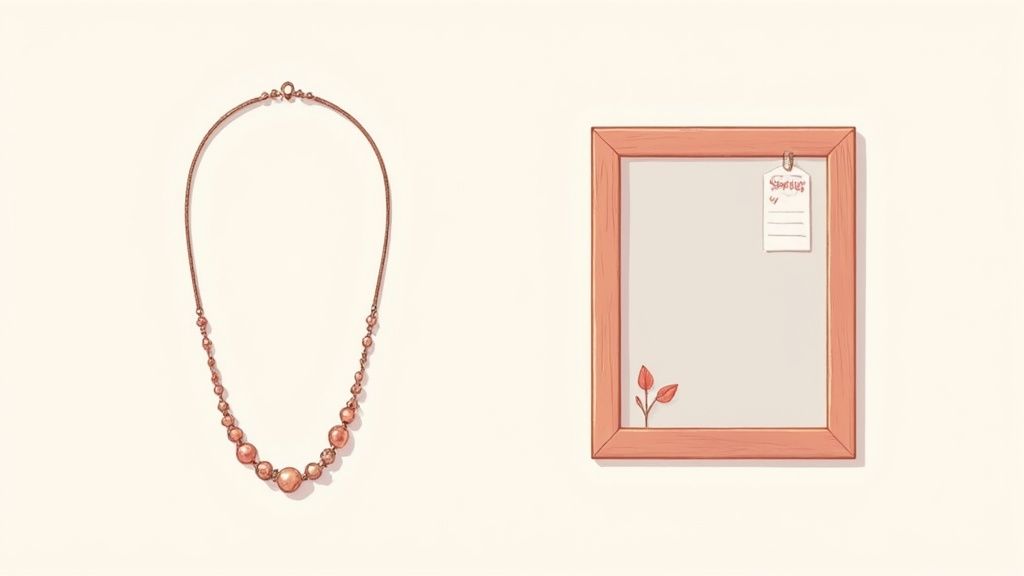
No estate sale exists in a vacuum. It's tied directly to the wider world, and grasping those connections is a cornerstone of any effective estate sale pricing guide. Think of yourself as a ship captain; you have to know which way the wind is blowing and how the currents are running to plot the best course.
The same is true for pricing. The big-picture forces, from the economy to the latest fads on social media, have a massive say in what people will actually pay for the items in a home. When you learn to read these trends, you can fine-tune your pricing strategy for a far more profitable sale.
Riding the Waves of Economic and Cultural Shifts
What’s happening in the news and in our culture has a very real, very tangible impact on your price tags. One of the biggest tailwinds for estate sales right now is the major cultural shift toward sustainability and thrifting. This isn't just a niche hobby anymore—it’s gone completely mainstream.
More than ever, shoppers are making a conscious choice to buy secondhand. They want to reduce waste and make a smaller environmental footprint. This is a huge advantage for you. People aren't just hunting for a cheap deal; they're actively seeking out well-made, unique items that have a story. That gives you the green light to price quality goods at their true worth.
Global economics also plays a huge part. As worldwide inflation and economic uncertainty make people more budget-conscious, the demand for second-hand goods naturally rises. At the same time, this makes buyers more sensitive to price, so you have to find that sweet spot. These forces are dynamic, and in some cities, the growth of the thrift economy is estimated to be over 10% year-over-year. You can find more about these trends in estate sales and how they shape pricing to get a deeper understanding.
Decoding Current Design and Collector Trends
So, what’s "in" right now? Knowing the answer can be the difference between an item selling for $20 or $200. Keeping an eye on interior design magazines, blogs, and collector forums is like having a cheat sheet for what will fly out the door.
Here’s a look at how specific trends can play out in your sale:
- Hot Styles: Is mid-century modern furniture still commanding top dollar? Has the "Grandmillennial" trend brought back a love for ornate china patterns and chintz? A little research tells you which styles are in demand, giving you the confidence to price those key pieces higher.
- The Power of Nostalgia: Trends are cyclical. That forgotten 1990s band t-shirt or those colorful 1980s kitchen canisters could suddenly be hot commodities. Nostalgia is an incredibly powerful sales driver.
- Collector Crazes: Sometimes, a specific category of collectibles can explode in value seemingly overnight. Think about the recent booms in the markets for vintage video games, Pokémon cards, or even certain types of vinyl records. Spotting one of these can be a major win.
Your job is to connect the items in the home to the desires of the current market. A piece isn't just "old furniture"; it's a potential "boho-chic centerpiece" or a "classic mid-century statement piece."
Of course, the flip side is just as important. You have to be realistic about what's "out." That massive, beautifully crafted entertainment center built for a bulky tube TV now has very little value, no matter how much it cost new. Acknowledging which items are outdated is just as crucial as capitalizing on the trendy ones.
By staying tuned in to these external forces, you can price with precision and turn your market knowledge into real profit.
Your Top Estate Sale Pricing Questions Answered
Even with a solid plan, you're bound to run into a few tricky pricing situations. Let's tackle some of the most common questions that pop up when you're in the thick of it, so you can price your items with confidence.
How Do I Price Something with Sentimental Value?
This is, without a doubt, the toughest part for most people. The secret is learning to separate your emotional attachment from an item's real-world market value. That armchair might be where your grandfather told the best stories, but a shopper will only see it for its condition and style.
First, do your homework. Find out what similar items have actually sold for recently. If that number feels too low and you can't stand the thought of letting it go for that price, don't sell it. It's much better to keep it in the family or simply hold onto it yourself. Trying to force a high price based on memories almost guarantees it won't sell, and you'll just be left with the item and a feeling of disappointment.
Should I Put a Price Tag on Every Single Thing?
Goodness, no! That would take forever and can actually overwhelm shoppers. For all the small, everyday items, your best friend is "lot pricing." This just means grouping similar things together and selling them as one unit.
Here are a few ways this works in practice:
- Grab a box and fill it with mismatched kitchen gadgets. Mark the whole thing $10.
- Fill a Ziploc bag with random craft supplies for $5.
- Tie a string around a stack of old paperback books and sell the bundle.
This strategy is a huge time-saver. It clears out clutter fast and appeals directly to bargain hunters looking to scoop up a deal. Save the individual price tags for items that are truly worth pricing on their own.
Is It Better to Hire a Pro or Do It Myself?
This really boils down to your own time, expertise, and the size of the estate you're dealing with. If you run the sale yourself, you keep 100% of the profits. But you're also responsible for 100% of the work—the sorting, the research, the setup, the advertising, everything.
A professional company will take a commission, usually between 30-50% of the total sales, but they handle it all from start to finish. They have the experience to price things right, a network of regular buyers, and the process down to a science.
If you're dealing with a massive estate, a collection full of high-value antiques, or you just don't have the time and energy to do it right, hiring a professional is often money well spent. If you need help deciding, there's plenty of great estate sale help available to help you weigh the pros and cons for your unique situation.
Ready to unlock the stories and value of your finds? Curio is your go-to companion for identifying and appraising items on the spot. Just snap a photo to learn an object's history and estimated worth. Download Curio today and turn your discoveries into knowledge: https://www.curio.app
